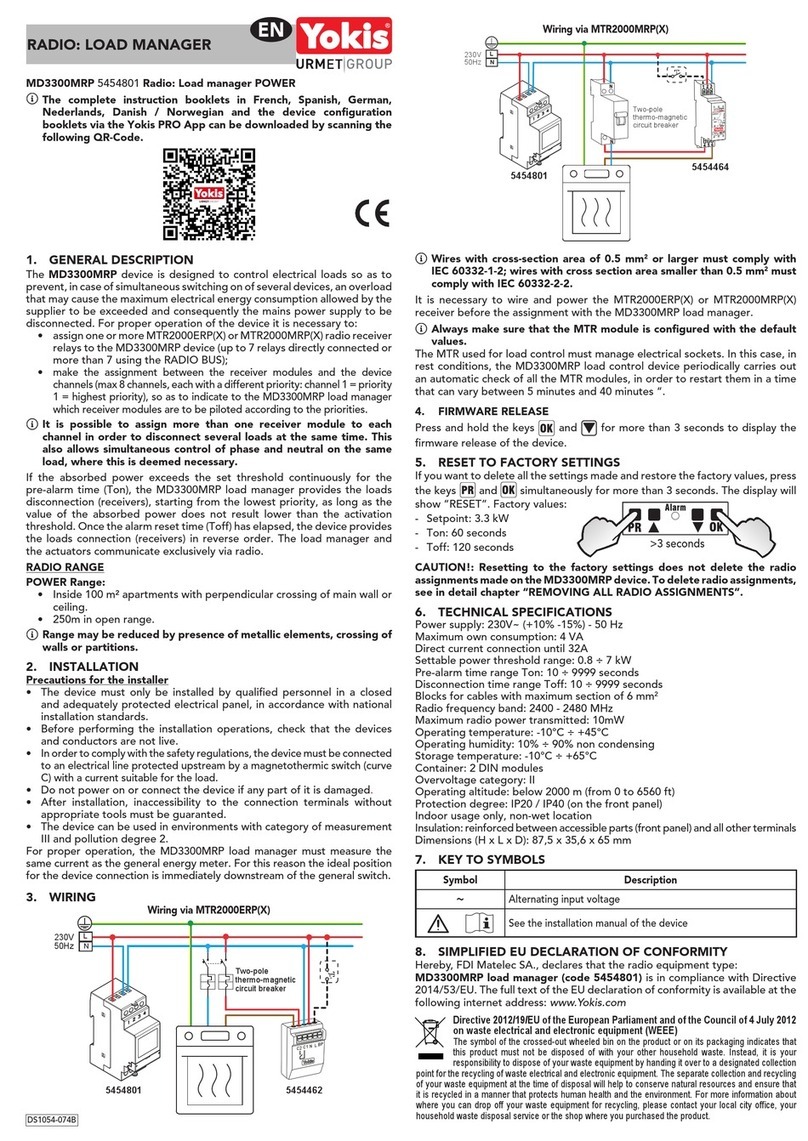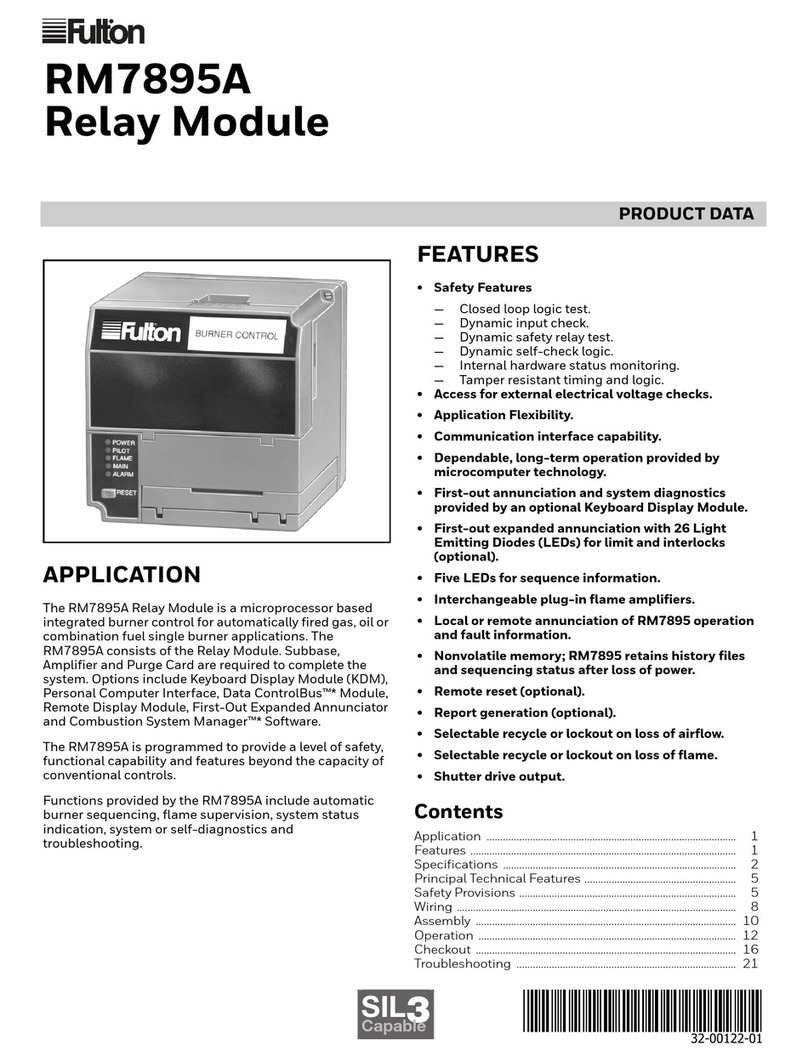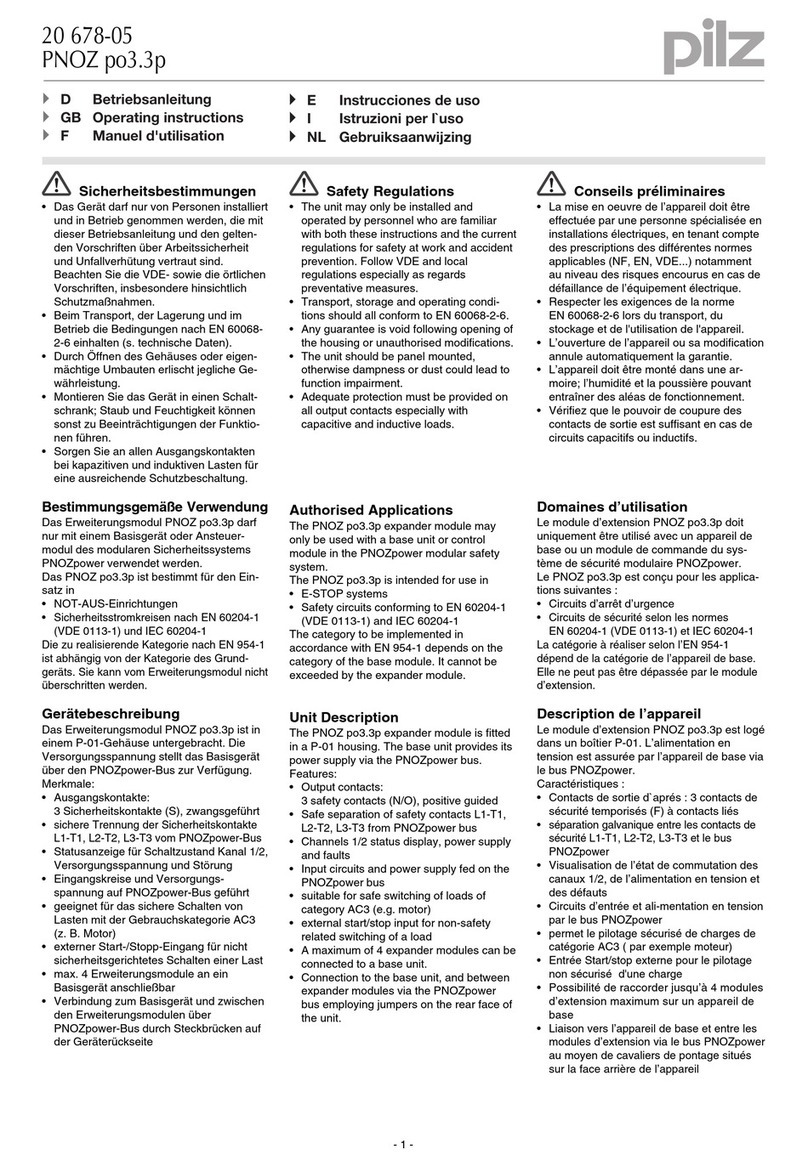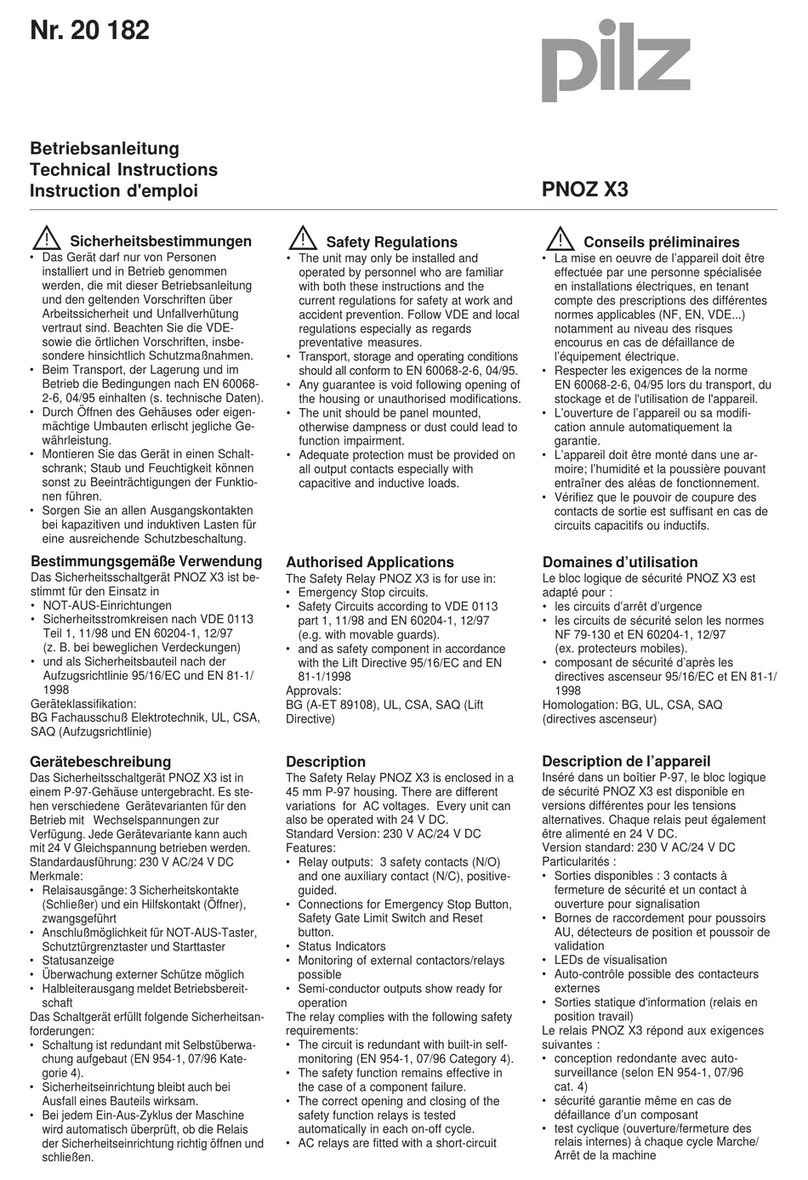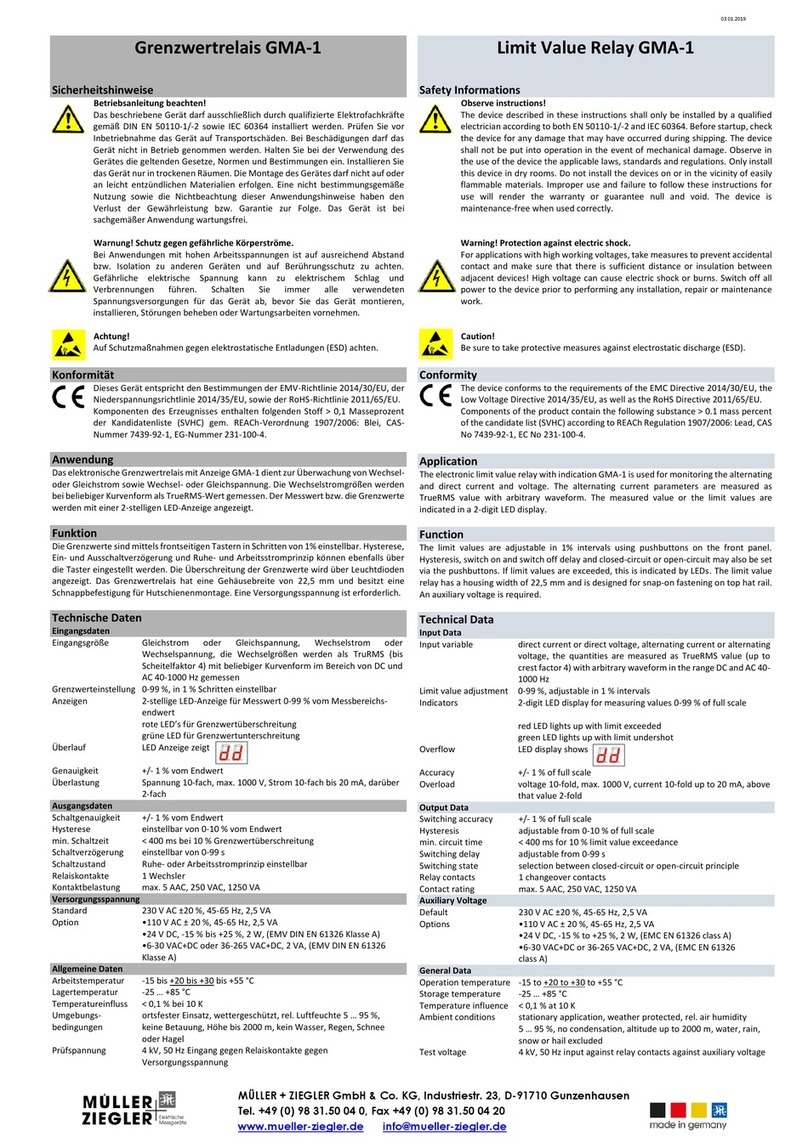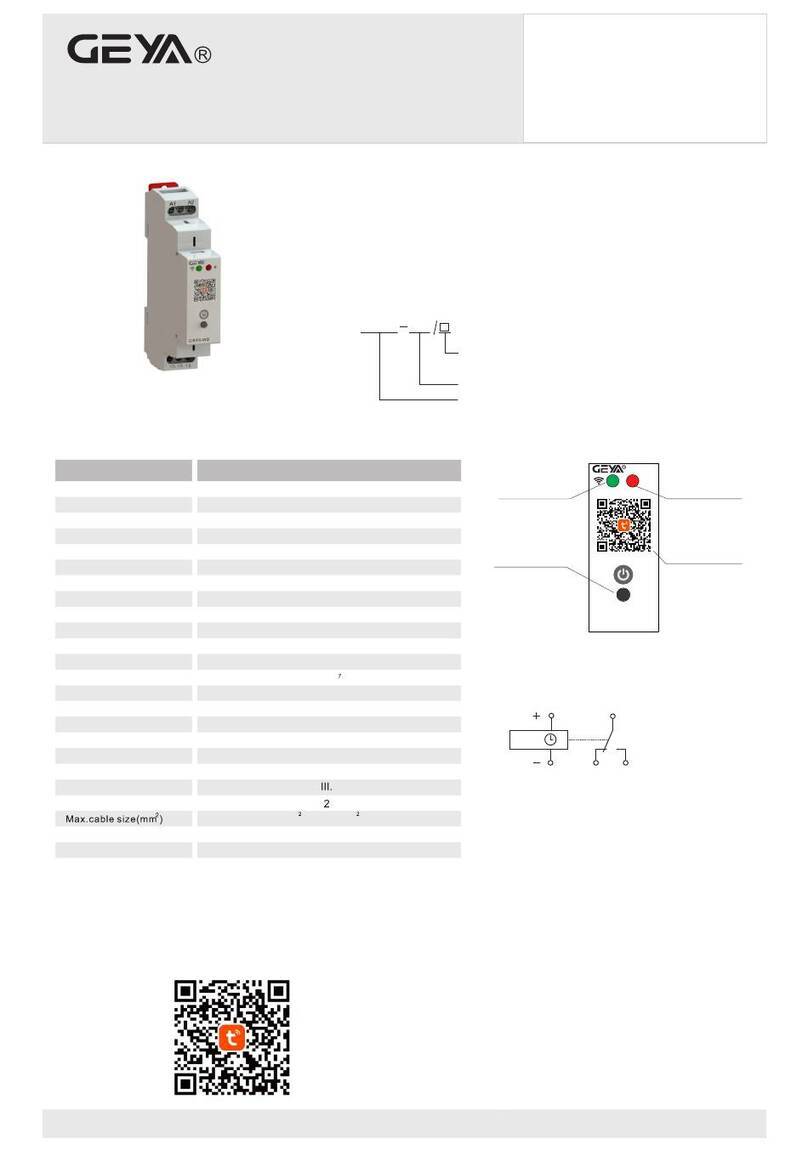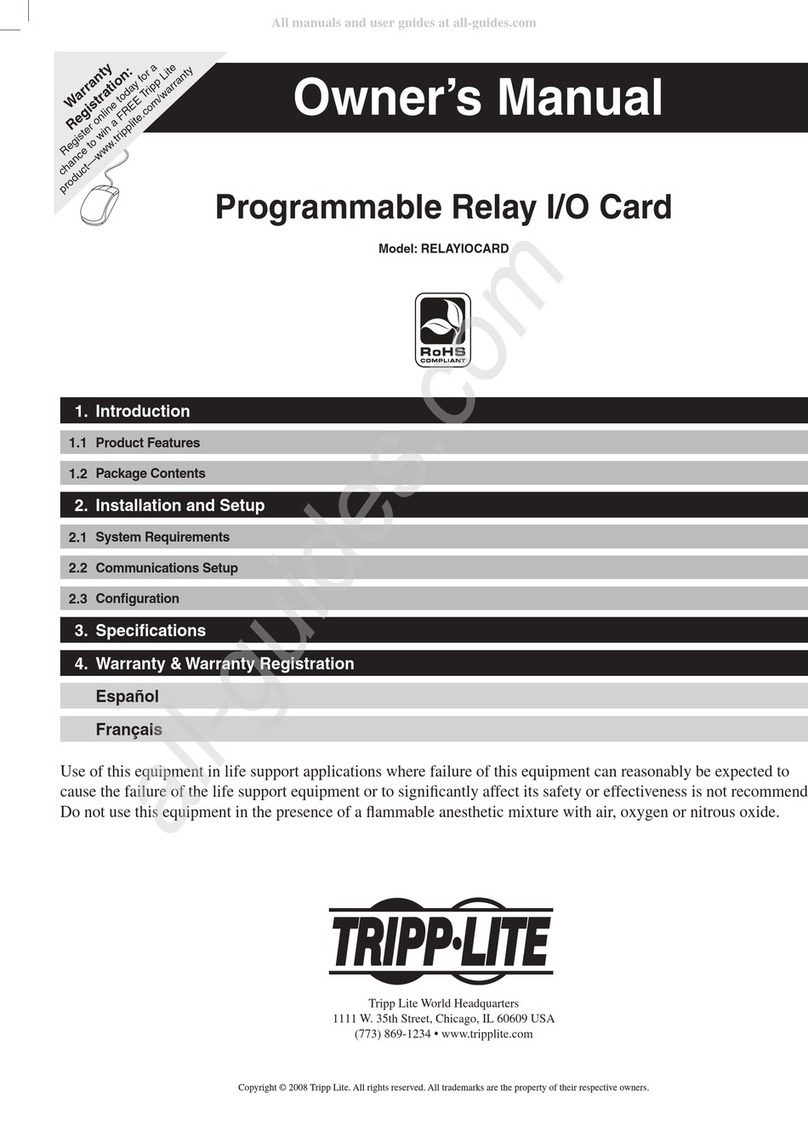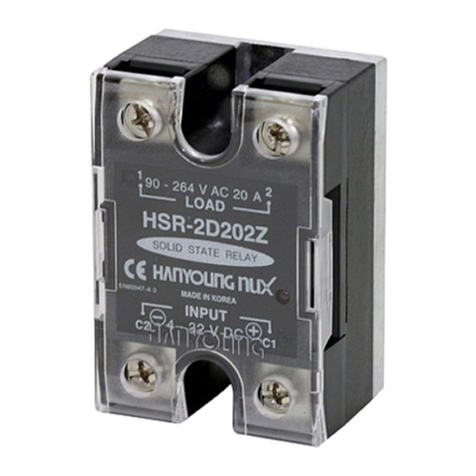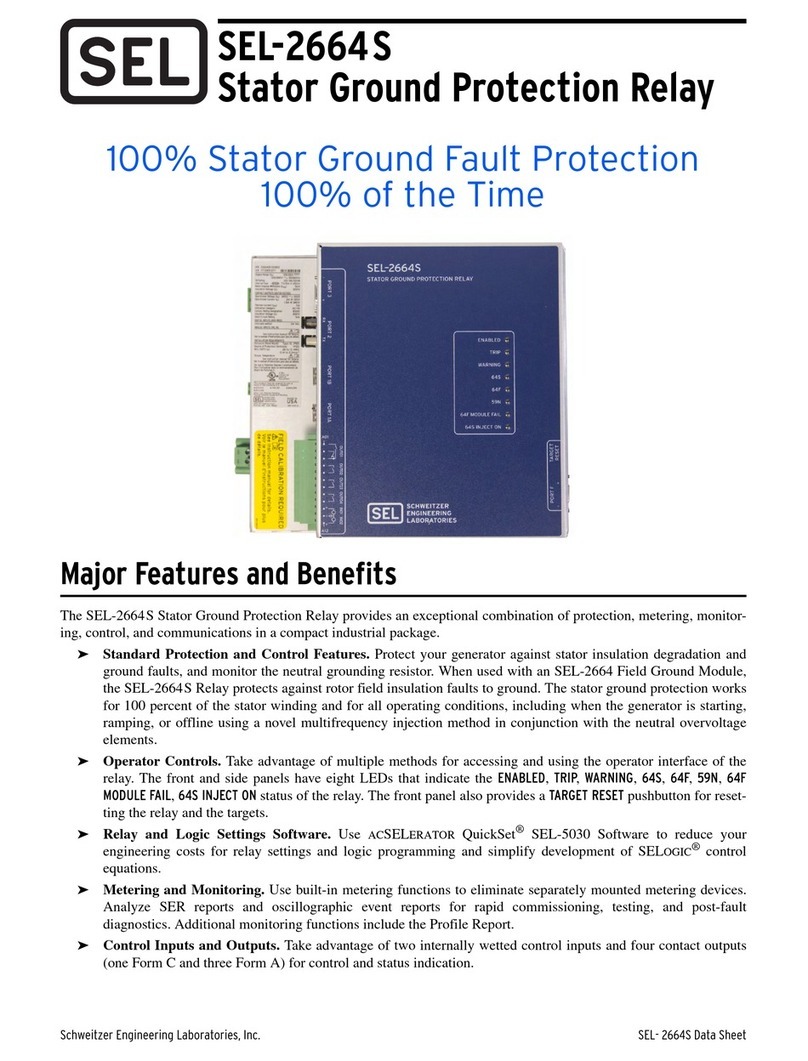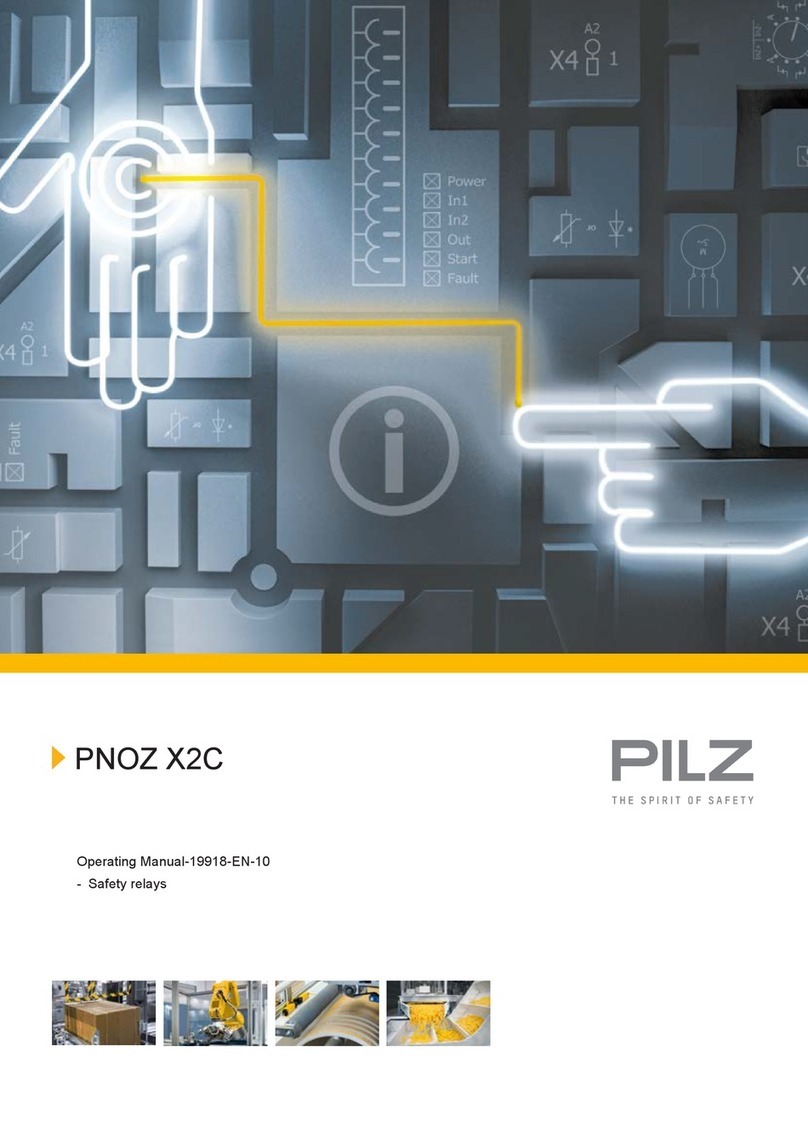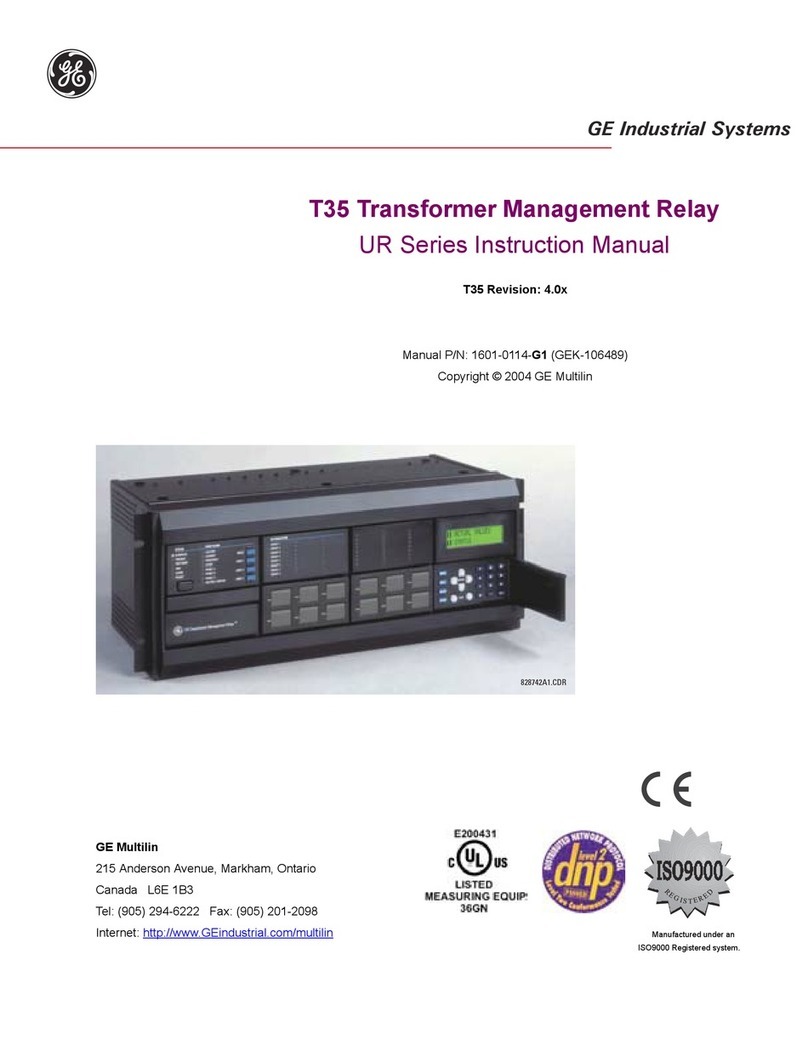RMS 1S20 User manual

1S20 User Guide
Arc Fault Monitor
relay monitoring systems pty ltd
Advanced Protection Devices
User Guide
Test Manual

1S20
User Guide
About This Manual
This User Guide covers all 1S20 relays manufactured from June 2005. Earlier relays do not
necessarily incorporate all the features described. Our policy of continuous may means that extra
features & functionality may have been added.
The 1S20 User Guide is designed as a generic document to describe the common operating
parameters for all relays built on this platform. Some relay applications are described but for specific
model information the individual “K” number Product / Test manuals should be consulted.
The copyright and other intellectual property rights in this document, and in any model or article produced
from it (and including any Registered or unregistered design rights) are the property of Relay Monitoring
Systems Pty Ltd. No part of this document shall be reproduced or modified or stored in another form, in any
data retrieval system, without the permission of Relay Monitoring Systems Pty Ltd, nor shall any model or
article be reproduced from this document without consent from Relay Monitoring Systems Pty Ltd.
While the information and guidance given in this document is believed to be correct, no liability shall be
accepted for any loss or damage caused by any error or omission, whether such error or omission is the
result of negligence or any other cause. Any and all such liability is disclaimed.
Contact Us
©Relay Monitoring Systems Pty Ltd 2001-2005
6 Anzed Court • Mulgrave 3170 • AUSTRALIA
Phone 61 3 9561 0266 • Fax 61 3 9561 0277
Email [email protected] • Web www.rmspl.com.au
To download a PDF version of this guide:
http://www.rmspl.com.au/userguide/1S20_user_guide.pdf
To download the model specific Test Manual:
http://www.rmspl.com.au/search.asp

How this guide is organised
This guide is divided into five parts:
Part 1 Overview
About this Manual
Contents
Test Manual
Part 2 Mechanical Configuration
Part 3 1S20 Arc Fault Monitor Technical Bulletin
1S30 Arc Fault Sensor Technical Bulletin
Part 4 Installation
Handling of Electronic Equipment
Safety
Unpacking
Mounting the 1S20 Arc Fault Monitor
Mounting the 1S30 Arc Fault Sensors
1S20 Configuration Switches
Equipment Connections
Operating Conditions
Part 5 Maintenance
Mechanical Inspection
Speed of Operation Performance Testing
Test Intervals
Defect Report Form
Visit www.rmspl.com.au for the latest product information.
Due to RMS continuous product improvement policy this information is subject to change without notice. 1A54_Guide/Iss B/24/07/06

Part
1
Test Manual
This User Guide covers all 1S20 relay versions & describes the generic features & attributes
common across all versions.
Different relay versions are required to cater for varying customer requirements such as auxiliary
voltage range, I/O configuration, case style, relay functionality etc.
The product ordering code described in the Technical Bulletin is used to generate a unique
version of the relay specification & is called a type number. The type number takes the form
1S20Kxx where the Kxx is the “K” or version number.
Refer to: www.rmspl.com.au/handbook/PARTA3.pdf
for a complete description of the RMS “K” number system.
Each 1S20 version has a specific Test Manual which provides details on the unique attributes of
the relay. Each Test Manual includes the following information:
•Test Certificate
•Specific technical variations from the standard model if applicable
•Test & calibration record
•Wiring diagram
A Test Manual is provided with each relay shipped.
If you require a copy of the Test Manual for an RMS product the following options are available:
•Check the RMS web site at: www.rmspl.com.au/search.asp
•RMS CD catalogue select: List all Product/Test Manuals under Technical Library
•Contact RMS or a representative & request a hard copy or PDF by email.
Visit www.rmspl.com.au for the latest product information.
Due to RMS continuous product improvement policy this information is subject to change without notice. 1A54_Guide/Iss B/24/07/06

Part
2
Mechanical Configuration
Great care has been taken to design a rugged, cost effective & flexible mechanical solution for
the 1S20 series Arc Fault Monitor. The ZA12 case MATRIX range provides a compact draw out
case solution with M4 screw terminals:
•1S20 surface mount type ZA12 plastic case suitable for surface or DIN rail mounting
•1S20 panel mount type ZA12 plastic case suitable for through hole panel mounting
•1S30 arc sensor Surface mounting plastic mousing
The 1S20 is configured in a ZA12 case & the following photographs depict the general mechanical
configuration.
Front view of panel mount version
Note combined tri-colour LED & reset button
Visit www.rmspl.com.au for the latest product information.
Due to RMS continuous product improvement policy this information is subject to change without notice. 1A54_Guide/Iss B/24/07/06

Front view of surface mount version
Note separate tri-colour LED, reset button, type number detail & retention screws
Rear view of 1S20 Arc Fault module Rear view of panel mount version terminal base
Note wiring diagram & configuration switches Note type number detail & retention screws
Visit www.rmspl.com.au for the latest product information.
Due to RMS continuous product improvement policy this information is subject to change without notice. 1A54_Guide/Iss B/24/07/06

1S20 Arc Fault Monitor shown un-plugged from terminal base
Note gold PCB contacts
Internal view of panel mount version PCB Internal view of surface mount PCB
Note combined tri-colour LED & reset button Note separate tri colour LED & reset button
Visit www.rmspl.com.au for the latest product information.
Due to RMS continuous product improvement policy this information is subject to change without notice. 1A54_Guide/Iss B/24/07/06

Part
3
Technical Bulletin
The detailed technical attributes, functional description & performance specifications for the 1S20
are described in the attached Technical Bulletin. For the most up to date version go to:
www.rmspl.com.au/handbook/1S20.htm
For any specific attributes of a particular version refer to the Test Manual for that type (K)
number.
The order of precedence for technical information is as follows:
•Test Manual
•Technical Bulletin
•User Guide
Visit www.rmspl.com.au for the latest product information.
Due to RMS continuous product improvement policy this information is subject to change without notice. 1A54_Guide/Iss B/24/07/06

Visit www.rmspl.com.au for the latest product information.
Due to RMS continuous product improvement policy this information is subject to change without notice. 1S20/Issue R/28/02/2010 - 1/11
Features
Compact, economic design
Simple panel mounting for
retrofit applications
Two or three arc sensor inputs
Two high speed tripping duty
arc sense output contacts
Push button reset
Continuous arc sensor
supervision
Integrated self supervision
Fail alarm contact
20-60 & 36-150V DC auxiliary
versions
Introduction
Medium voltage switchgear is a key
element in the power supply chain.
Existing protection systems operate
effectively under most circumstances, but
they are too slow to handle arcing short
circuits.
Arcing faults can occur as a result of
insulation breakdown due to equipment
age & / or poor maintenance.
The degree of damage caused by arcing
depends principally on the duration of the
arc. If an arc lasts only 100ms, the
switchgear needs to be checked & the
insulation resistance measured before
power can be re-established. With a
200ms arc, the power supply will be
interrupted; the switchgear must be
checked; power is re-established only
after minor repairs. In the event of a
500ms arc the supply is interrupted, metal
parts of the switchgear are destroyed &
poisonous gases are emitted. A 1s arc
destroys most of the switchgear & may
cause a fire, injury to personnel & damage
to property.
The over-current caused by an arc is, due
to its resistance, lower than the over-
current caused by a “metallic” short circuit.
The over-current caused by the arc may
also be lower than the protection start
current when energising circuits or starting
large motors. The consequence of these
conditions is that a protection system
based solely on over-current detection
cannot effectively discriminate between
normal system currents & an arc fault
condition:
•For moderate arc fault currents the trip
time of the over-current IDMT stage will
be too slow;
•For very low arc fault currents the
instantaneous trip stage of a standard
over-current relay cannot be set low
enough.
Technical Bulletin 1S20
Arc Fault Monitor Relay
1S30 Sensors - front & back 1S20 depicted in panel mount case configuration
ARC Fault Protection Made in Australia
Arc fault protection is a relatively new technique employed for the fast clearance of arcing
faults on BUS bars & within metal clad switchgear & associated cable boxes. The arc is
detected using an optical sensor & the signal input to a protection device which also
monitors the load current on the system. A trip signal can be achieved in less than 10ms
using arc detection only or within 15ms when using overcurrent check. This is considerably
faster than a traditional IDMT overcurrent relay & provides additional protection from the
onset of arcing faults with relatively low fault currents.
Arguably the greatest risk of arc fault damage exists at the CB cable termination & in the
CB chamber itself due to the slow clearance times of the IDMT feeder protection. The CB
cable termination is particularly at risk to ingress of moisture & rodent damage.
The problem of arc faults is most prevalent in older metal clad switchgear which already
has operational protection systems. The 1S20 Arc Fault Monitor has therefore been
designed for the following applications:
EXISTING SWITCHGEAR
Where a requirement exists to retrofit arc fault protection to metal clad switchgear utilizing
the existing overcurrent protection relay;
NEW SWITCHGEAR
Where a requirement exists to install arc fault protection to new switchgear for integration
with the customer preferred overcurrent feeder protection relay.

Visit www.rmspl.com.au for the latest product information.
Due to RMS continuous product improvement policy this information is subject to change without notice. 1S20/Issue R/28/02/2010 - 2/11
SWITCHGEAR ARC PROTECTION
Risk of arc fault damage exists at the CB cable termination & in
the CB chamber itself. The CB cable termination is particularly at
risk to ingress of moisture & rodent damage.
One, two or three arc sensors may be connected to the 1S20 Arc
Fault Monitors as depicted in the single line application diagrams
at right.
Figures 1 & 2 show the trip signals being used to trip the feeder
circuit breaker in the event of an arc fault occurring at any sensor
provided the overcurrent relay starter contact is picked up. In
these applications the overcurrent check stage is optional as the
consequence of a single feeder outage is less than the loss of an
entire BUS.
Figure 3 shows an application where a single 1S20 is applied for
the protection of the Cable box, CT chamber & CB chamber using
three sensors. In this configuration one arc trip output is used to
trip the feeder circuit breaker in the event of an arc fault in the
cable box / CT chamber. The second trip output is set for
independent operation to trip the BUS breaker (BUS overcurrent
check not shown), in the event of an arc fault in the CB chamber.
EXISTING SWITCHGEAR APPLICATIONS
The existing overcurrent relay protecting the feeder will normally
provide an independent output contact associated with the start
current setting of the relay. That is an output contact that will
close when a phase or earth fault current is detected above the
threshold which starts the internal relay timers. This starter
element should be set for instantaneous operation so that it will
pick up in the order of 15ms.
An Arc Fault Monitor relay 1S20 is installed on the switchgear
panel adjacent to the protection relay. The 1S20 is specifically
designed for simple retrofit to existing panels & requires only a
single 31mm mounting hole to be drilled. The 1S20 fits through
this hole, the designation label supplied with the unit positioned &
the retention shroud fitted. Refer Figure 12 & 13.
1S30 optical arc sensors are fitted in the cable termination box &
CT chamber as depicted in figure 2.
The overcurrent relay starter contact may optionally be wired in
series with the arc fault detection trip output contact as depicted
in figure 6. The resulting “AND” function trip output is wired to trip
the breaker in ~15ms in the event that an arc fault is detected
while the overcurrent start element is picked up.
The second arc trip & fail alarm contacts may be employed for
interface to a SCADA system for fault reporting.
NEW SWITCHGEAR APPLICATIONS
For new switchgear installations a modern numeric feeder
protection relay is likely to be employed which will have numerous
programming & configuration options.
The basic concept is the same as for the existing switchgear
application described above except that the additional features &
flexibility of modern feeder protection relay allows improved
system integration.
This may be achieved by using the second arc trip output contact
to interface to a programmable status input on the feeder
protection relay. Depending on the model of protection relay
being used this input may be programmed to provide an alarm
message on the HMI, time stamped event record available via its
communications link.
Where this level of system integration is employed the 1S20 does
not need to be mounted on the front panel as the alarm
indications are available on the feeder relay. Remote reset of the
1S20 LED is achieved by momentary interruption of the power
supply using a SCADA controlled series contact. The DIN rail
mounting option is a convenient alternative in this situation.
Switchgear Applications
Figure 1:
Single arc sensor - Cable box only
(Optional overcurrent check stage depicted)
1S30
1S20
50/51
Figure 2:
Two arc sensors - Cable box & CT chamber
(Optional overcurrent check stage depicted)
1S30
1S30
1S20
50/51
Figure 3:
Two arc sensors - Cable box & CT chamber
Independent trip to CB
(Optional overcurrent check stage depicted)
1S20
1S30
1S30
1S30
50/51
Trip BUS CB(s)
1S20
1S30
1S30
1S30
50/51
Trip BUS CB(s)
One arc sensor - CB chamber
Independent trip to BUS breaker
(BUS overcurrent check stage not shown)

Visit www.rmspl.com.au for the latest product information.
Due to RMS continuous product improvement policy this information is subject to change without notice. 1S20/Issue R/28/02/2010 - 3/11
COMBINED BUS BAR & SWITCHGEAR ARC PROTECTION
Figure 4 shows an application where a single 1S20 is applied for
the protection of the Cable box & CT chamber plus the CB
chamber & BUS chamber using three sensors.
In this configuration one arc trip output is used to trip the feeder
circuit breaker in the event of an arc fault in the cable box / CT
chamber. The second trip output is set for independent operation
to trip the BUS breaker (BUS overcurrent check stage not
shown), in the event of an arc fault in the CB chamber or BUS
chamber.
Figure 4:
One arc sensor - Cable box / CT chamber
Independent trip to CB
Two arc sensors - CB chamber & BUS chamber
Independent trip to BUS breaker
(BUS overcurrent check stage not shown)
BUS Bar Applications
BUS BAR ARC PROTECTION
Figure 5 depicts how the 1S20 may also be applied for the
protection of bus bars. The number of sensors in the bus
chamber is dictated by the switchgear design and the length of
switchboard.
In most indoor metal clad switchgear the bus bar chamber is a
continuous chamber between panels only broken into segregated
sections at a bus section breaker & as such the strategic
placement of one or two arc sensors in each bus bar chamber run
is normally adequate.
Some indoor metal clad switchgear may segregate the bus
chamber of each panel from the next via insulated bus chamber
side barriers per panel, if this is the case then each bus chamber
per panel would need to be monitored by at least one arc sensor.
1S20
1S30
1S30
1S30
50/51
Trip BUS CB(s)
1S20
1S30
1S30
1S30
50/51
Trip BUS CB(s)
In large enclosures the arc sensors should be placed at
approximately 5m intervals.
1S20
1S30 1S30
50/51
50/51 50/51
Figure 5:
One, two or three arc sensors located in the BUS chamber

Visit www.rmspl.com.au for the latest product information.
Due to RMS continuous product improvement policy this information is subject to change without notice. 1S20/Issue R/28/02/2010 - 4/11
OPERATION INDICATOR
A single tri colour LED is integrated into the front panel reset push
button to provide the following status indications:
Solid red for 2s followed by:
Alternate red & green until reset.
Green solid
Orange flashing
Orange solid
Alternate orange & red.
System healthy
1S30 Arc Sensor 2 or 3 service
1S30 Arc Sensor 1 service
1S30 Arc Sensor continuous pick up
Flash green 3 times1S30 Power up test OK
Arc fault trip
ARC SENSOR CIRCUIT SUPERVISION
The 1S30 Arc Sensor is the heart of the system & supervision of
circuit continuity is critical for correct operation. To monitor the
integrity of the wiring between the 1S30 arc sensor & 1S20 Arc
Monitor, a continuous 2mA supervision current flows between the
units. The 1S20 alarm contact will drop out after a 1s time delay if
it fails to detect this current.
Where a fault is detected on the Arc Sensor 1 circuit the front
panel LED will give a solid orange indication.
Where a fault is detected on Arc Sensor 2 or 3 circuits the front
panel LED will give a flashing orange indication.
Where a fault is detected on Arc Sensor 1 & 2 or 1& 3 circuits the
front panel LED will give a solid orange indication.
Operation
ARC SENSOR FUNCTION
The 1S30 is an optical sensor that responds to the flash of light
emitted during the incidence of an arcing fault. Onset of the light
flash & detection by the 1S30 occurs in a few ms.
When an arc is detected, the resistance presented by the 1S30
drops to a level where the current flow increases to approximately
20mA. This increased current flow is instantaneously detected by
the 1S20 & its trip output contacts closed. Refer to the 1S30
Technical Bulletin for further details.
ARC FAULT TRIPPING USING CURRENT CHECK
Fast operation of a tripping scheme usually results in reduced
system security. The arc detection method can however, combine
the 1S20 optical detection technique with a traditional overcurrent
method to maximize system security particularly for BUS bar
protection schemes. Both conditions must coexist for the trip
condition to be met as depicted in figure 6.
Type:1S20K1 [C] Vx: 48V DC
Serial No : 126578
1S20 Arc F ault Monitor
ARC FAULT TRIP INITIATE
CB
A
RC FAUL
T
MONITORSENSOR
OVER-CURRENT RELA
Y
3 Pole OC + EF
RESET / TEST
System F unctioning
Arc Faul t Trip
System Service
DC Fail
GREEN:
RED:
ORANGE:
DARK:
Figure 6:
Key components required to implement an Arc Fault Protection
scheme with an overcurrent check stage
to enhance system security
The application examples in figures 1 to 5 utilize this concept for
enhanced system security in that both the 1S20 AND the OC 50
starter contact must be picked up for a CB trip signal to be
initiated. As the arc fault trip contact picks up considerably faster
than the overcurrent relay starter element, the CB trip time will be
dictated by the overcurrent relay performance.
LOW CURRENT ARCING FAULTS
Arcing faults can occur at low current levels & it is possible for the
over-current starter element to be set above this level. To avoid
this problem & obtain very fast clearance (<10ms), of an arc fault,
the 1S20 arc fault trip contact may be wired directly to the breaker
operate coil. It should be noted that this method may lead to
reduced system security.
ARC DETECTION RESET TIME (Effect of multiple arc trips)
A delay of 2s is required to reset the 1S20 after an initial arc
sensor trip. Subsequent arc detection will cause the trip output
contacts to re-operate & reset the time delays described under
Configuration Switch Settings.
INDEPENDENT TRIP OUTPUT CONTACTS
The 1S20 may be set using configuration switch 3 for both trip
output contacts to pick up when an arc is detected by any sensor
input. Alternatively arc sensor 1 can be linked to trip contact 1 &
arc sensor 2 (& 3 if fitted), to trip contact 2. This function may be
applied where an arc fault detected in the cable box is directed to
trip the feeder circuit breaker while an arc fault in the BUS
chamber is to be directed to trip the BUS.
ARC SENSOR CONTINUOSLY PICKED UP
High ambient light levels may cause a 1S30 to be continuously
picked up. This condition could occur for example if the CB cable
box cover was left open in very high ambient light level
conditions. A non arc fault over-current pick up would then result
in an arc fault trip operation.
To avoid possible mal operation due to this condition, the 1S20 is
designed to automatically disable the arc fault tripping function if
the 1S30 sensor is picked up for >10s. The 1S20 alarm contact
will be set & the front LED flash alternate orange & red until the
ambient light level problem is corrected. The 1S20 will then
perform an arc sensor test function & automatically reset.

Visit www.rmspl.com.au for the latest product information.
Due to RMS continuous product improvement policy this information is subject to change without notice. 1S20/Issue R/28/02/2010 - 5/11
Figure 7: 1S20 rear view showing configuration switches
Configuration
CONFIGURATION SWITCH
The configuration switches are accessible to the user by first
unplugging the electronic module from the terminal base as
shown in Figure 7.
ON
ON
ON
ON
ON
OFF
OFF
OFF
OFF
OFF
1: ARC SENSOR 2
2: LATCHING TRIP LED
3: INDEPENDENT ARC TRIP
4: LATCHING TRIP CONTACTS
5: ARC SENSOR 3
CONFIGURATION SWITCH SETTINGS
The internal wiring label identifies the position of the following
switch functions:
Switch 1: Arc sensor 2
ON - Arc Sensor 2 fitted
OFF - Arc Sensor 2 not fitted
Switch 2: Arc fault trip indication LED reset
ON - Latching until manually reset
OFF - Automatic self reset (Extinguish) after 4 hours
Will also reset contacts set for latching function
Switch 3: Independent arc trip output contacts
ON - Arc Sensor 1 activates trip output contact 1 &
Arc sensor 2 or 3 activates trip output contact 2
OFF - Arc Sensor 1, 2 or 3 activate both trip outputs
Switch 4: Arc fault trip output contact reset
ON - Latching – Reset with trip LED
OFF - Self reset after 2s
Switch 5: Arc sensor 3
ON - Arc Sensor 3 fitted
OFF - Arc Sensor 3 not fitted

Visit www.rmspl.com.au for the latest product information.
Due to RMS continuous product improvement policy this information is subject to change without notice. 1S20/Issue R/28/02/2010 - 6/11
Wiring Diagrams
2
1
3
4
5
6
8
9
12
11
10
Figure 8: 1S20 Socket Terminal Layout viewed from the front when un-plugged from the main housing
Note: * Always wire Arc Sensor 1. Arc Sensors 2 & 3 are optional.
1S20 application dia
g
ram - Circuits shown in de-ener
g
ised condition
12
8
10
9
9 or 11
5
1
3
11
6
2
4
Vx
+
+
Fail
alarm
Arc 1
(Must be wired)
Arc 3 Arc 2
Arc fault trip alarm signal to
protection relay status input for comms.
I>start
Control
Protection
1S20
50/51
Overcurrent
relay
Arcfault
relay
I>
CBAux Switch Trip Coil
52
T
52 - a
Figure 9: 1S20 Wiring application diagram

Visit www.rmspl.com.au for the latest product information.
Due to RMS continuous product improvement policy this information is subject to change without notice. 1S20/Issue R/28/02/2010 - 7/11
MOUNTING OPIONS
The 1S20 is available in two versions:
1. A surface mount version which has a separate reset button &
LED indicator on the front panel. The advantage of this
version is the lower cost & where front panel space in limited.
2. A panel mount version which has a combined reset button &
LED indication. The advantage of this version is that it can be
either panel or surface mounted.
SURFACE MOUNT VERSION
This version is suitable for location in the rear of a cubicle. It may
be surface mounted as shown in figures 10 & 17. It may also be
DIN rail mounting when the optional 290407157 DIN Rail
Mounting Kit is fitted. Refer figures 11, 18 & 19.
Figure 10: 1S20 surface mount version front panel
SERIAL NO. &
RATING LABEL
ON MODULE SIDE
FOR PANEL
MOUNT VERSION
REMOVE FOR
REAR CABLE
ENTRY OPTION
REMOVE FOR
TWO M4 OR 4BA
MOUNTING SCREWS
TOP & BOTTOM REAR
TERMINAL BLOCK
RETAINING SCREWS
SLIDE OUT CABLE
ENTRY POINTS
3 ON ONE SIDE
1 AT EACH END
1S20K2 (CAB)
AUX:36-1 50V DC S/N:123456
Figure 11: Surface mount version side view
Mounting Options
PANEL MOUNT VERSION
This version is suitable for mounting on the front panel of a
cubicle or door. This is achieved using a 31mm diameter hole in
the panel adjacent to the protection relay as depicted in figures
12, 13 & 14.
This version may also be surface mounted by reversing the
terminal block retaining screws. It may also be DIN rail mounting
when the optional 290407157 DIN Rail Mounting Kit is fitted.
Refer figures 15, 16 & 19.
Figure 12: 1S20 through hole panel mount version
Use double sided tape supplied
Top & bottom positions
RELAY PANEL
3mm THICK
MAXIMIUM
FRONT PANEL
LABEL
(Supplied with module)
SLIDE OUT CABLE
ENTRY POINTS
3 ON ONE SIDE
1 AT EACH END
TOP & BOTTOM REAR
TERMINAL BLOCK
RETAINING SCREWS
THESE MAY BE
UNSCREWED &
REVERSED TO FIT
FROM THE FRONT OF
THE 1S20 MODULE TO
ALLOW SURFACE
MOUNTING
RETENTION
SHROUD
1S20 Arc Fault Monitor
RESET / TEST
System Functi oning
Arc Fault Trip
Sensor 1 Serv ice
Sensor 2 or 3 Servi ce
Continuou s Sensor P/U
DC Supply Fail
GREEN:
RED:
ORANGE S OLID:
ORANGE FLASH:
ORANGE / RED:
NONE :
Figure 13: Panel mount version side view

Visit www.rmspl.com.au for the latest product information.
Due to RMS continuous product improvement policy this information is subject to change without notice. 1S20/Issue R/28/02/2010 - 8/11
Panel Mount Version
Figure 14: Panel mounting cut out detail
Figure 15: Surface mounting detail
Figure 16: DIN rail mounting detail

Visit www.rmspl.com.au for the latest product information.
Due to RMS continuous product improvement policy this information is subject to change without notice. 1S20/Issue R/28/02/2010 - 9/11
Surface Mount Version
Figure 17: Surface mounting detail
Figure 18: DIN rail mounting detail
DIN RAIL
MOUNTING KIT
901-500-040
Iss A (20/11/09)
Figure 19: DIN rail clip fitting detail – Specify DIN Rail Mounting Kit P/N 290407157

Visit www.rmspl.com.au for the latest product information.
Due to RMS continuous product improvement policy this information is subject to change without notice. 1S20/Issue R/28/02/2010 - 10/11
AUXILIARY SUPPLY BURDEN (At 110V DC)
Monitoring mode: Less than 4W
Arc fault detected: Less than 10W for 2s
AUXILIARY SUPPLY
20 - 60V DC
3
6 – 150V DC
OPERATE TIME
Arc fault trip contacts guaranteed to pick up in less than 10ms
including bounce. Typical operate time is 7ms.
CRO trace showing nominal operation time of the trip contacts at
7ms. First contact touch at 6.25ms and fully closed by 7.25ms.
Operation in <10ms is considered acceptable as current check
relay operate time is ~15ms.
ARC SENSOR INPUTS
Two or three independent arc sensor inputs type 1S30 or similar.
Figure 20: 1S30 Arc Fault Sensor (Refer 1S30 Technical Bulletin)
MINIMUM ARC DURATION
The minimum arc “flash” duration required to guarantee operation
of the output contacts is 1.25ms.
TRIP CONTACT RESET TIME
Once operated the trip output contacts reset as per the
configuration switch 4 setting.
MANUAL RESET
Press front button or interrupt power supply to reset LED’s.
Technical Data
OUTPUT CONTACTS
Arc fault trip contacts: 2 N/O
Fail alarm: 1 N/C for the power supply / CPU fail
Normally picked up & drops out to
signal an alarm condition.
OUTPUT CONTACT RATINGS IEC60255-0-2
Carry continuously 5A AC or DC
0.5s 20A AC or DCMake & carry
L/R ≤40ms & V ≤300V 0.2s 30A AC or DC
AC resistive
AC inductive
1,250VA
250VA @ PF ≤0.4
DC resistive 75W
Break capacity
I ≤5A & V ≤300V
30W @ L/R ≤40ms
DC inductive 50W @ L/R ≤10ms
Minimum number of operations 106at maximum load
Minimum recommended load 0.5W limit 10mA / 5V
TRANSIENT OVERVOLTAGE IEC60255-5
Between all terminals & earth 5kV 1.2/50us 0.5J
Between independent circuits without
amage or flashoverd
5kV 1.2/50us 0.5J
INSULATION COORDINATION IEC60255-5
Between all terminals & earth 2.0kV RMS for 1 minute
Between independent circuits 2.0kV RMS for 1 minute
Across normally open contacts 1.0kV RMS for 1 minute
AUXILIARY SUPPLY IEC60255-11
Allowable breaks / dips in supply
Collapse to zero from nominal voltage ≤20ms
HIGH FREQUENCY DISTURBANCE IEC60255-22-1 CLASS III
2.5kV 1MHz common mode
1
.0kV 1MHz differential mode No mal operation
ELECTROSTATIC DISCHARGE IEC60255-22-2 CLASS III
6
kV contact discharge No mal operation
RADIO FREQUENCY INTERFERENCE IEC60255-22-3
10V/m, 80 TO 1,000MHz No mal operation
FAST TRANSIENT IEC60255-22-4
4kV, 5/50ns, 100KHz repetitive No mal operation
CONDUCTED RFI IEC60255-22-6
10V, 0.15 to 80MHz No mal operation
TEMPERATURE RANGE IEC68-2-1/2
Operating: -5 to +55oC
Storage: -25 to +75oC
HUMIDITY IEC68-2-78
40 oC & 95% RH non condensing
CASE
ZA12 flush or DIN rail mount type
12 M4 screw terminals
Plug in module to facilitate easy wiring & fast changeover
AC AUXILIARY SUPPLIES (PS5R-A24 MODULE)
The Idec PS5R DIN rail mount power supply is suitable for
providing the 24V DC auxiliary supplied required for operating the
S20 Arc Fault Monitor from an AC auxiliary.1
Vx input: 85 to 264V AC
Power output: 7.5W continuous

Visit www.rmspl.com.au for the latest product information.
Due to RMS continuous product improvement policy this information is subject to change without notice. 1S20/Issue R/28/02/2010 - 11/11
CONFIGURATION CODE (Optional specification)
The configuration code can be set in the field by withdrawing the
relay module & following the instructions on the side plate label.
The configuration code may be specified at time of order so that
the relay will be shipped from the factory pre-set to meet
customer requirements. e.g. CONFIG-01011
If a configuration code is not specified the factory default will be
set as indicated below. i.e. CONFIG-11111
Configuration
Switches
Specify factory
Configuration 1 2 3 4 5
CONFIG -
1 ARC SENSOR 2
1 ON Arc sensor 2 fitted (Default)
0
OFF Arc sensor 2 not fitted
2 ARC FAULT TRIP INDICATION RESET
1 ON Latched until manually reset (Default)
0 OFF Auto reset after 4 hours
3 INDEPENDENT ARC TRIP OUTPUTS
1 ON Arc sensor 1 operates trip output 1
Arc sensor 2 operates trip output 2 (Default)
0 OFF Arc Sensor 1 or 2 operate both trip outputs
4 TRIP OUTPUT CONTACT RESET
1 ON Latching – Resets with trip LED (Default)
0
OFF Self reset after 2s
5 ARC SENSOR 3
1 ON Arc sensor 3 fitted (Default)
0 OFF Arc sensor 3 not fitted
Ordering Information
Generate the required ordering code as follows: e.g. 1S20-CAB
1 2 3
1S20 Arc Fault Monitor Relay
1 AUXILIARY SUPPLY RANGE
A 20 - 60V DC
C
36 - 150V DC
2 MOUNTING
A Panel mount or surface mount *
B Surface mount only *
3 SENSORS
A Two arc sensor inputs (Default)
B Three arc sensor inputs
Note: * Where DIN rail mounting is required specify DIN Rail
Mounting Kit P/N 290407157
PS5R POWER SUPPLY MODULE
Use the PS5R-A24 DIN rail mount module to power a single 1S20
from an 85-164V AC auxiliary source.
1S30 ARC FAULT SENSOR
Refer to the 1S30 Technical Bulletin for ordering information on the
Arc Sensor.

Visit www.rmspl.com.au for the latest product information.
Due to RMS continuous product improvement policy this information is subject to change without notice. 1S30/Issue G/18/07/11 - 1/5
Features
Compact rugged design
One or two optical detectors
High speed arc detection
Heavy duty 6m termination
cable
Optional 20m & screened
cables
Simple flush panel mounting
outside or inside switchgear
compartment
Integrated sensor circuit
supervision
Very low sensitivity to ambient
light levels to avoid nuisance
tripping even in direct sunlight
Sealed module for harsh
environments
Optional metal reinforced
mounting shield
Application
Arc fault protection is a relatively new
technique employed for the fast clearance
of arcing faults on BUS bars & within
metal clad switchgear & associated cable
boxes. The arc is detected using an
optical sensor & the signal input to a
protection device which also monitors the
load current on the system. A trip signal
can be achieved in less than 10ms using
arc detection.
RMS manufactures a protection class arc
fault optical sensor & monitoring system
suitable for both low & medium voltage
switchgear and BUS bar applications.
1S20 3 sensor, 2 zone Arc Fault Monitor
1S25 8 sensor, 4 zone Arc Fault Monitor
1S26 1S25 with integrated current check
1S30 Optical Arc Fault Sensor
While the high intensity flash caused by an
electrical arc will be reflected within the
metal clad switchgear, it is recommended
that one or more sensors be mounted in
each enclosed switchgear compartment.
For BUS bar protection applications
multiple sensors are required to achieve
adequate coverage along the length of the
BUS. A sensor version with two optical
detectors “looking” in opposite directions is
available for this purpose (Refer figure 3
for generic layout).
Technical Bulletin 1S30
Optical Arc Fault Sensor
1S30 Arc Fault Sensors
Through panel mounting detector Front panel view of dual detector
View depicted at left version depicted at right
Description
Made in Australia
The 1S30 is an optical sensor that responds to the flash of light emitted during the
incidence of an arcing fault. Onset of the light flash & detection by the 1S30 occurs in a few
ms.
Each arc fault sensor consists of one or two silicon PIN photo diode light detectors
mounted on a circuit board together with the associated detection circuit (Figures 1 & 2).
The detector monitors a wide space angle. A broad spectral response in the visible region
is provided as depicted in figure 5.
Sensitivity of the arc sensor has been set to a low level to reduce the possibility of mal
operation under high ambient lighting conditions. This is made possible due the high
intensity of light emitted under arc fault conditions. Additional security can be incorporated
by way of a current check stage as described in the 1S20 Arc Fault Monitor Technical
Bulletin.
In stand by mode the 1S30 sensor presents a high resistance to the 12V DC control signal
provided by the 1S20, 1S25 or 1S26 Arc Fault Monitors. This allows a small circulating
current to flow for continuous supervision of the 1S30 connection circuit. When an arc is
detected, the resistance presented by the 1S30 drops to a level where the current flow
increases to approximately 20mA. This increased current flow is instantaneously detected
by the Arc Fault Monitor & its trip output contacts closed. Refer to the 1S20 Arc Fault
Monitor Technical Bulletin for further details.
This manual suits for next models
1
Table of contents
